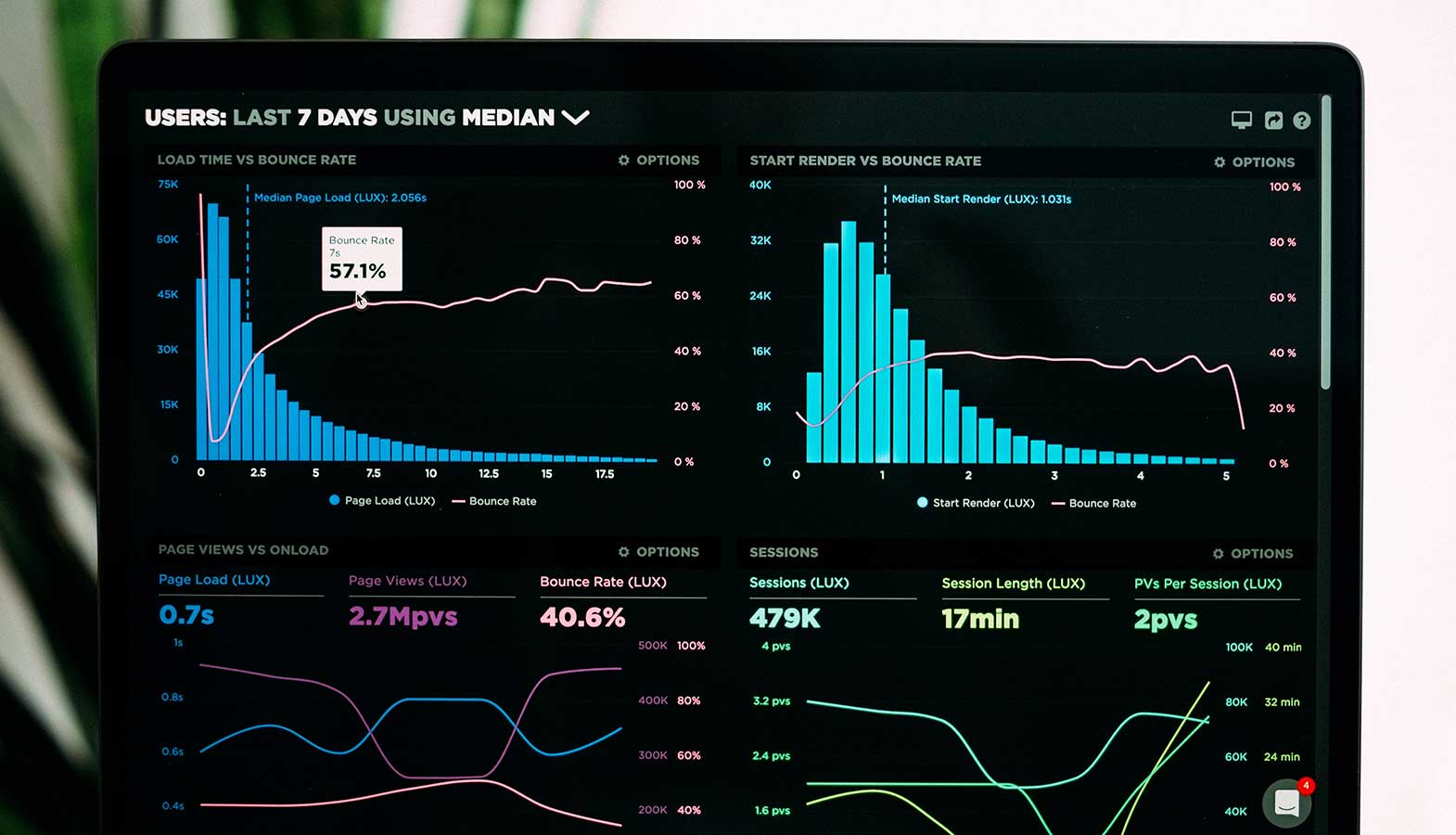Website performance metrics are crucial to your online success.
As a website owner or even a developer, you spend a lot of time and energy maintaining your website. Your website performance metrics provide valuable insight into how it’s doing and where there’s room for improvement.
What does an improvement mean for you? Higher rankings, better traffic, and more conversions.
With so many website performance metrics to choose from, knowing which ones to monitor and analyze can be difficult.
Over the years, our web designers have created a time-tested list of the most important website performance metrics we test every custom website design we create against during our quality assurance phase and throughout our post-launch support.
It’s important to us that we deliver a successful website to our clients. Here’s our must-read guide on the 19 website performance metrics you should understand and keep an eye on for online success.
Why Are Website Performance Metrics Important?
Website performance metrics are valuable data. This data shows you how a site visitor interacts with your website. You can then use this data to identify areas where users’ movements and actions are the weakest.
With this data, you can make better-informed design and marketing decisions. Ultimately, you need to understand your the technical aspects of website performance metrics to decrease slow load times and increase lead conversion.
When deciding which website metrics to focus on, you need to have a look at your main goals. This will help narrow down the list of essential metrics that you need to keep an eye on.
Here are three key goals for site owners:
Improve Your Ranking
Suppose your goal is to reach that coveted number one spot on the search engine result pages (SERPs). In that case, you must focus on metrics that align with search engine optimization.
So, you may have to track metrics such as keyword ranking, traffic sources, and unique visitors.
Improve Your Conversions
If your goal is to improve your online sales, you must focus on tracking conversion rates across all web pages. In short, these are metrics such as lead generation, top pages, and session duration.
Improve Your User Experience
Finally, you may want to improve the user experience on your website. In that case, you need to focus on website performance metrics such as bounce rates, page load time, and session durations and improve overall user satisfaction.
With so many metrics involved, it’s important to understand this process takes time, user input and patience to achieve results. While it may be tempting to only focus on the best-performing metrics, you must decide on what goals you’d like to achieve. Use your goals as a guide to select which metrics to track and improve.

Boost Conversion Rates With These 19 Website Performance Metrics To Monitor
Regardless of your business goals, here are 19 overarching website performance metrics that impact user behavior and overall web performance. Tracking these metrics can help show you where you need to make adjustments in order to improve your rankings, conversions, user experience, and more.
1. Website Speed
Website speed is a very important metric that can result in poor performance or a successful website.
In 2010, Google announced that site speed (or load time) would be a ranking factor. Google will penalize slow websites, and they’ll drop in ranking.
The developers behind Google reason that the faster a web page loads, the better the user experience is. And it makes sense. We’re used to a fast-paced world, and attention spans are getting shorter. This means that if a website is slow to load, users will get frustrated and will likely just click away to find what they need elsewhere.
A website that loads faster will improve the user experience, making it better for everyone. This measure of overall website performance is made up of individual metrics from Google’s Core Web Vitals algorithm update that relies on everything from your web server to real user monitoring.
So, how do you improve your website speed? There are three essential metrics to monitor.
Time To Title
Time To Title refers to the time a visitor waits before your website’s title appears on their browser tab. The shorter this time is, the better. When your title appears early, internet users feel they can trust your website.
Time To Start Render
Time To Start Render is the time elapsed between a user request and the moment when items materialize on the user’s browser. Like Time To Title, the faster this happens, the more likely your visitor will stay on the webpage.
Time To Interact
The final speed metric is Time To Interact. This time is the period between items loading and when a visitor can take action. An action can be anything from clicking on links, scrolling through the page, or even typing.
Time To First Byte
Time To First Byte (TTFB) is another essential website speed metric. TTFB is the time it takes for personalized information to reach a visitor’s web browser. Customized information is anything unique to your website, i.e., titles, content, or dynamic information.
Google recommends that your TTFB is less than 200 milliseconds.
There are several ways to improve TTFB. For instance, you can optimize your code to parse personalized information faster.
Keeping an eye on these performance metrics can ensure that visitors stay on the page for longer. You’ll also be able to reduce bounce rates and improve the user experience.
Use page speed tools, such as Google’s PageSpeed Insights, to see how fast, or slow, your website is.
2. Number Of Assets
The number of assets on your page refers to all the components, such as text, images, videos, audio, etc.
It’s essential to optimize the number of assets. All these components have a file size. The bigger they are, the slower your site performs.
Since website speed is a ranking factor, you want to improve loading speeds. Slow speeds will harm your overall ranking, leading to fewer visitors and even fewer conversions.
If you find that your assets are slowing your site’s performance, we recommend hosting them on an external site. You could also try to use fewer assets to speed up your site.

3. DNS Lookup Time
DNS Lookup Time, also called DNS Lookup Speed, is the time it takes your Domain Name System (DNS) provider to translate a domain into an IP address.
Not all DNS providers are equal. Some are faster, and some could be slower. Using a slow DNS provider could slow down your DNS lookup.
One solution is to find a premium provider. They can ensure a shorter DNS time, even though this service comes at a price.
We recommend you run a speed test using any of the freely available online tools. Find a provider that guarantees a speed you’re comfortable with.
4. Error Rate
The Error Rate is an important metric for tracking the percentage of errors on your website. Without it, your website will lose users and have a weaker business.
How does it work?
The Error Rate is the percentage of issues compared to the total number of requests received. A request happens when a visitor lands on your web page, and their browser “requests” to load some assets. If something goes wrong and the browser doesn’t receive the requested information, it results in an error.
Errors like this will harm your user experience and cause an increase in the bounce rate.
By tracking this metric, you can identify spikes in error requests. This website performance metric can help diagnose and repair issues before they harm your traffic and ranking.
5. Top Pages
Top Pages are the pages on your website that perform the best. These pages often get the most traffic, have the least bounce rates, and have higher conversion rates.
Like in any business, staying on top of what works well is essential. When you monitor your top-performing pages, you can also identify pages that aren’t performing so well.
Improve these pages by incorporating what works in your top-performing pages.
Do they have a specific call-to-action that performs better than others? Do these pages have better loading speeds or perhaps fewer assets?
Since top pages can generate leads, it’s essential to keep your eye on them to ensure they’re helping you meet your business goals.
6. Unique Visitors
Use the Unique Visitors metric to determine the number of unique visitors to your website.
As much as repeat business is essential, generating new leads will help your website to grow. With this metric, you can analyze how many unique visitors your website gets over a specified period.
The number of unique visitors is an excellent way to gauge your marketing effectiveness. Work on developing a strategy to help increase those numbers if you aren’t satisfied with them.
Some things you can do is try and rank for more keywords, consider running paid adverts, or add new content to your website.
You can view the number of unique visitors through a monitoring tool like Google’s Analytics platform. Simply browse over to the audience tab for an overview.
7. Traffic Source
Traffic source helps you to determine where your website traffic comes from.
Online traffic can come from various sources. For example, you can get traffic to your website from social media, referrals, or organic searches.
You can determine your most vital sources when you review your traffic sources. You’ll also be able to see which sources are performing poorly.
Use this data to optimize your traffic, and increase it. If your traffic isn’t evenly split between sources, we recommend you adjust your marketing strategy to rebalance this.
If you want to see where your website’s traffic is coming from, visit Google Analytics. Go to Acquisition, All Traffic, and then select Channels.
Here you’ll have an entire overview of various traffic sources.

8. Bounce Rate
The higher your bounce rate is the poorer your website’s performance and user experience.
Your bounce rate is determined by how many users land on your website and click away within a second without visiting a second page and lowering the average session duration.
Search engines view a bounce rate as indicating a poor user experience. The user either didn’t find what they had expected when they clicked on your website, or the user experience was so bad that they exited the page immediately.
There are many factors that contribute to this issue. Essentially, a high bounce rate indicates that your site isn’t delivering what it’s promising to.
You can easily view the bounce rate in your Google Analytics account. Simply navigate to Behavior, Site Content, and then choose the Landing Pages Report. When you scroll down in this report, you’ll see this metric displayed.
To reduce bounce rates and retain visitors, you can do any of the following:
- Ensure your website speed is optimal. The faster, the better.
- Have quality content. Genuine, helpful content will ensure visitors can easily find the information they are looking for and are engaged so they stay on your website for a longer time.
- Use a variety of media. Images, videos, text, and easy-to-understand titles will improve user engagement.
Check out this fantastic guide on reducing your bounce rate if you find this metric to be a problem.
9. Session Duration
Session duration is a crucial website performance metric. It indicates how long a user stays on your website. The longer a user is on your website, the more engaged they are.
When session durations become very short, search engines will start counting them as bounces. Remember, a high bounce indicates that there is an issue with your website design, content, or speed. So, you’ll want to do everything you can to fix this to keep users engaged for longer.
If your session duration is low, then it’s time to develop a strategy to increase user retention.
Here are some ways that you can increase the session duration:
- Create engaging, helpful content. Quality content will keep users engaged. They’ll read, listen, or view your content. This means they won’t click away from your site to find better content elsewhere.
- Improve the user experience. It’s essential to ensure your website is easy to use and navigate. Keep the navigation logical and simple. Make content easy to view and consume.
10. Conversion Rate
One of the most important metrics to measure performance is your conversion rate.
The conversion rate provides insight into your leads and how effective your website is in converting them into customers.
A conversion can be any online transaction. For example, conversions are when a user clicks on the Contact form, signs up for a newsletter, or buys a product on your website. It’s any action that you want a website visitor to take.
If you find that you have a low conversion rate and a high organic traffic rate, this most likely means that your marketing is great, but your website doesn’t deliver on its promises.
With the conversion rate metric, you can identify what users need to make that conversion. Luckily, Google can help track your conversions.
On your Google Analytics dashboard, navigate to Conversion. Choose Overview to generate a report with your conversion rate metric in it.
11. Keyword Ranking
While keywords’ search volumes and popularity can fluctuate, it’s important to keep an eye on your keyword rankings. This enables you to identify whether your search engine optimization strategy is working or not or whether you need to update certain content to rank better for your target keyword.
Use tools such as Ahrefs or Semrush to see how your website performs for specific keywords.
Develop a content marketing strategy if the SEO performance isn’t up to your standard.
Some things you can do to improve your keyword rankings are:
- Understand the competition. Look at what competitors for the same keywords are doing. What did they include in their content that you didn’t? Is there a way you can improve their content to provide more value to your target audience?
- Avoid keyword spamming. Don’t stuff keywords into your content. Search engines are clever and will penalize you.
- Do research. Fantastic research is crucial to your keyword strategy. Use tools and manual analysis to find the best keywords to rank for. Evergreen keywords are often better for your website as they will continue to draw traffic over time. Just remember to update it every now and then to keep it relevant!

12. Lead Generation
Another crucial web performance metric is lead generation. It’s essential to your website’s growth.
Lead generation tracks the number of visitors to your site through digital marketing channels such as paid adverts, social media marketing, or organic searches.
Leads are generally users who browse your website because they’re interested in your services. It’s your website’s job to turn leads into conversions.
To help you determine your lead generation metrics, look at bounce rate, session duration, and click-through rate (CTR):
- Bounce rates: When your lead generation works, your bounce rates on a specific landing page will be low.
- Session duration: Session durations are typically long when your lead generation is optimized. This is because the visitor is already interested in what you have to offer and has come to your site to learn more or take the next step.
- Click-through rates: A click-through is when a visitor clicks on an advert or link in your marketing campaign. The better your CTR, the better your lead generation as it means you’ve enticed people enough to click through to your website or landing page.
You can improve your lead generation by understanding who your target audience is. Ask yourself, what do users want from your website? How can you help visitors achieve their goals faster?
By better understanding your audience, you can create landing pages that address their unique needs and pain points. You’ll also be able to target your audience on the platforms that appeal to them the most.
13. Uptime
The duration that your website is live and working is crucial for pulling in those other great metric rates. The longer your website is up and running, the better your uptime metric will be.
Of course, your hosting company is a determining factor. Still, developers with new updates can also affect this website performance metric.
When deciding on a hosting server, try to determine the average time the server will be down. Most hosts will have an uptime percentage.
If that percentage is 99%, you can expect 7 hours of downtime per year. If that uptime is 99.9%, you can expect 45 minutes of downtime annually.
So, yes, even the decimal counts when you consider the uptime. Choose a host that has an acceptable downtime.
14. Third-Party Domains
It’s essential to monitor any third-party domains to improve website performance.
Sometimes, web developers host assets on third-party domains. Examples include videos hosted on YouTube, Twitter feeds, or social media widgets.
Having an embedded asset from a third party website doesn’t mean there won’t be hiccups. In fact, you have limited control over the functionality and speed of their load time.
If the third-party website is down or has a slow load time, you can guarantee that the content will affect site performance. Your error rate can also be affected. Poor page performance is an unfortunate consequence.
Using a waterfall analysis, you can determine the assets that are taking the longest time to load. From there, you can decide whether to remove them altogether.
If the third-party asset doesn’t add to the user experience and slows down your page speed, you’re better off removing it. However, if it forms a critical part of your marketing efforts, such as providing social proof, you may have to keep it.
15. HTTP Requests
Optimizing HTTP request times is crucial to ensure an optimal user experience.
An HTTP request happens whenever a user interacts with or clicks on your website’s content. Their browser sends a command to your website server, including third-party servers, to load code. This code typically includes HTML, CSS, and JavaScript. All of this tells the user’s browser how to display an asset and how that asset should behave.
If your server is slow, it’ll increase the wait time for HTTP requests. Slow speeds harm your user experience and lead to a slow, unresponsive website.
On the other hand, a large volume of traffic on your website can also increase the HTTP request times. So, you must use load testing tools to test your server and ensure it can handle large traffic volumes.
16. Accessibility Score
In both the US and Europe, accessibility is crucial in creating an accessible website for all users. It’s essential to ensure that your website is ADA-compliant and offers good user experience for all. This also includes optimizing for use on mobile devices.
By following the Web Content Accessibility Guidelines (WCAG), you can improve user experience and ensure that your site is accessible to everyone.
Some things that you can do to improve your website’s accessibility score include:
- Make sure you include ALT tags on all images.
- Use ARIA attributes.
- Include valid values of the language attributes.
- Include subtitles or closed captions on any videos.
When you optimize your website’s accessibility score, you’ll gain a new audience, more traffic, and better conversions.
You can easily assess your website performance and accessibility using an AI-based tool like accessiBe and even install their app to improve your scoring on the fly.
17. Establish SSL/TLS Time
This website performance metric refers to secure communications over the internet.
SSL, also known as Secure Sockets Layer, and TLS, known as Transport Layer Security, are two security protocols that protect user information online.
If your website doesn’t offer any of these security protocols, search engines may penalize it. However, just having one of these protocols isn’t enough. They need to be fast, too.
A slow SSL or TLS time can negatively impact your website’s performance.
The SSL or TLS Time measures how long it takes to conduct a TLS handshake. This means that both sides send messages to acknowledge and verify each other.
If this loading process is slow, consider changing your provider.

18. Audience Metrics
Tracking your audience will help you to see whether you’re targeting the right audience or not.
The audience metric is significant for websites that target a wide range of audiences and categories. It’s prevalent in e-commerce websites that sell a variety of products.
The audience metric will give you a clearer idea of whether your website or certain parts are doing their job to attract the right site visitors. You can also see which pages are most popular in certain age groups and genders.
With real user monitoring, you can improve your website and track user behaviour. You can optimize landing pages to address specific niche audiences for improved conversions.
You can use Google Analytics to get an overview of your site visitors. You’ll be able to see what devices they use to access your website, their demographics, and which audience segments convert better.
19. Site Authority
Site or domain authority is essential if you want to out-rank your competition in the SERPs.
Search engines, like Google, assign a domain ranking to every website. The domain ranking is based on the following:
- the quality of your content
- how long your website has been live
- how many other websites point to your website
When low-authority websites are linked to your website, they drag your site authority down. When a high-authority website links to your domain, your site authority improves, and you’ll rank higher in the SERPs.
So to improve your site authority, you need to score backlinks from high-authority sites when you do link-building or guest posting. Avoid directory services that sell backlinks. These sites often have a low site authority, and they’ll drag this website performance metric down.
Conclusion
It’s crucial to monitor your website performance metrics, whether it’s a brand-new or old website that’s been around for years.
Our complete list of 19 website performance metrics will help you maintain a clear view of what works on your website. You can use these metrics to improve the user experience, gain traffic, and optimize conversions.




